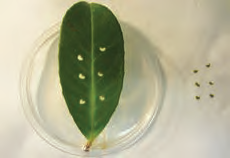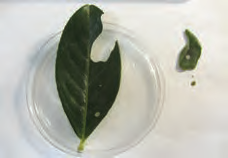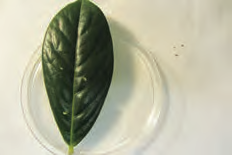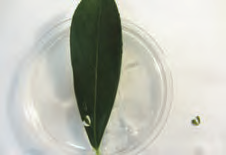Helen Grogan shares Teagasc/UCD research findings into one of the most visible Cherry Laurel diseases
Cherry Laurel (Prunus laurocerasus) is an important plant species for nurseries and cut foliage growers. The cultivar ‘Rotundifolia’, used widely for hedging, is the main one propagated in nurseries and is an important plant for export trade. The cut-foliage sector, on the other hand, mainly grows the cultivar ‘Etna’ along with smaller amounts of ‘Caucasica’ and ‘Novita’.
One of the most noticeable diseases to affect Cherry Laurel is shothole, which is predominantly caused by the bacterial pathogen Pseudomonas syringae pv syringae (Pss). Researchers at Teagasc and UCD have been working on this disease for the past three years and have made some interesting discoveries. Leighton Smith, a Masters student at UCD, studied the epidemiology of Pss on Cherry Laurel and found that the cultivars ‘Rotundifolia’ and ‘Novita’ displayed the most severe symptoms while ‘Caucasica’ was the least susceptible to shothole disease and ‘Etna’was somewhere in between (photo 4). Abiotic factors such as wounding (e.g. pruning, wind/insect damage), exposed sites and mild temperatures were all found to promote shothole disease and may account for why the disease can be prolific in nurseries and cut-foliage plantations. To sustainably reduce the occurrence of shothole, growers may need to consider providing more shade for Cherry Laurel (e.g. interplanting with taller species) or to counteract ‘wounding’ effects by reducing pruning events and protecting from insects.
Shothole symptoms on different cultivars of P. laurocerasus 28 days after infection with PSS. :
DISEASE-CAUSING ORGANISMS
Brian McGuinness and Danielle Boland at Teagasc surveyed 11 commercial Cherry Laurel plantations and seven nurseries in a systematic manner to obtain diseased material, and to identify the pathogens associated with shothole symptoms and other blemishes. In 2017, the predominant organism associated with disease symptoms was the Pss bacterium, with 28% of samples testing positive for the diagnostic syringomycin B gene (n=320). Shothole symptoms can vary from distinct ‘shotholes’ to leaf-edge necrosis, making the recognition of symptoms more challenging. Six per cent of samples were associated with a fungus identified as a Neofabraea sp., the first time this has been recorded on P. laurocerasus (photo 2), while the known P. laurocerasus fungal pathogen, Eupropolella britannica, was isolated from just two samples. Many samples yielded no pathogen, most likely because once shotholes have formed, the pathogen has been excised from the plant and is no longer present. Interestingly, another bacterial species, Micrococcus aloverae, was isolated from shothole symptoms on an infected ‘Rotundifolia’ hedgerow, so not all shothole symptoms are caused by the same organism. They may be a generalised response to infection, although this hypothesis needs further research.
Worryingly, Xanthomonas arboricola pv. pruni, a destructive pathogen of stonefruit Prunus species worldwide, such as peaches, apricots and plums, is also known to infect Cherry Laurel and produce a shothole like symptom. Currently, it is absent from the UK, which has ‘Protected Zone’ status, meaning it restricts imports of Prunus plants to countries that also have Protected Zone status. In Ireland, the Department of Agriculture, Food and the Marine is seeking ‘Protected Zone’ status for Ireland, which would be a distinct advantage for the sector, facilitating the growth of exports of P. laurocerasus cultivars for hedging.
In conclusion, from a plant health perspective, most shothole symptoms on Cherry Laurel in cut foliage plantations and nurseries are caused by Pseudomonas syringae pv syringae but other bacteria can cause similar damage so vigilance is needed to ensure that Xanthomonas arboricola pv. pruni is not imported on plants coming from outside non-protected zones. Ireland is well-placed to embrace sustainable Xanthomonas-free P. laurocerasus production for both cut foliage and hedging. ✽
  |











